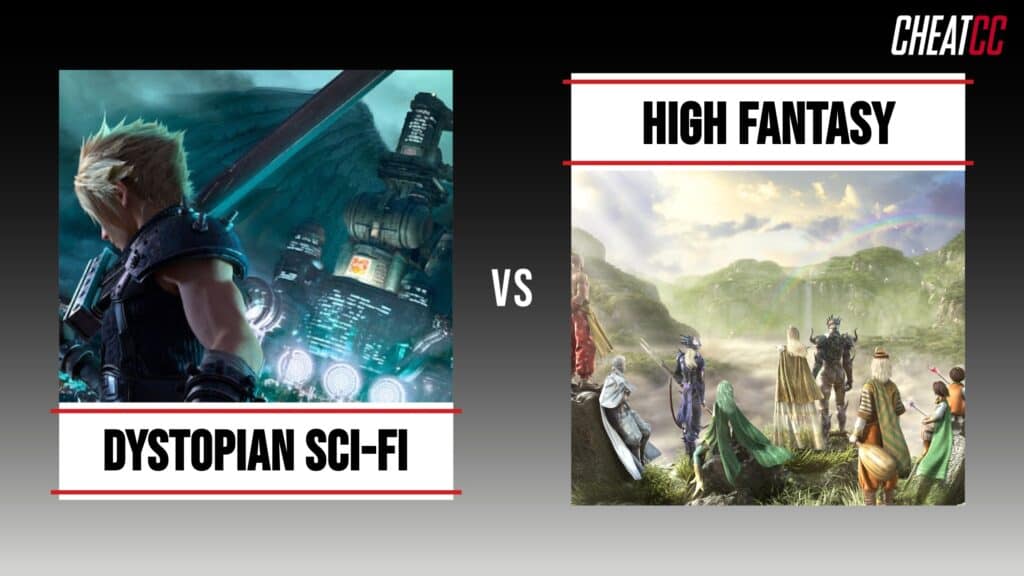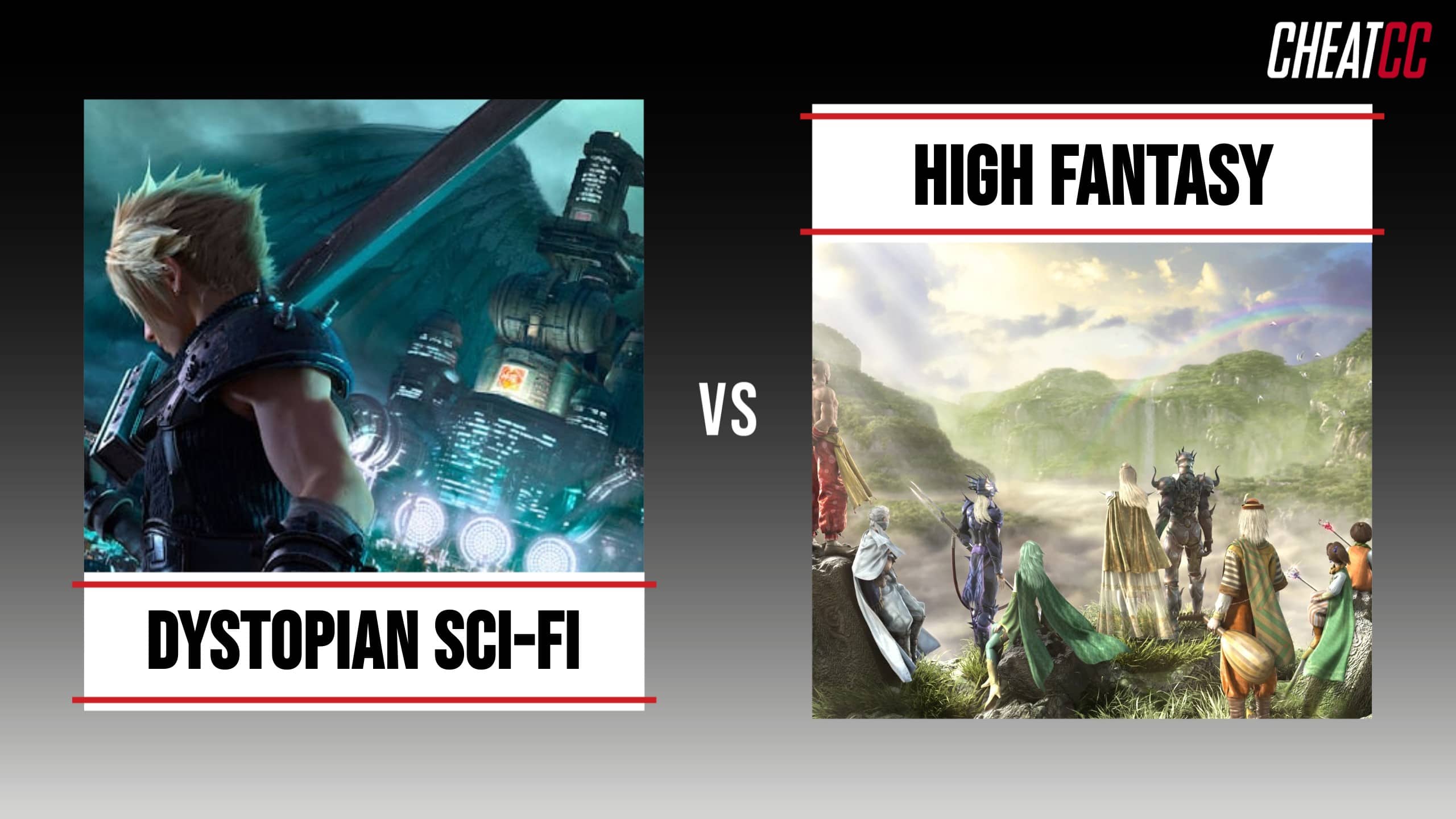Early on in the lifespan of the console RPG, Final Fantasy stood out for being one of the few series to seamlessly blend high-concept science fiction alongside the more traditional medieval fantasy tropes of tabletop and pen-and-paper RPGs. Not only did Final Fantasy‘s setting blend two genres in its storytelling to help it to stand apart from its closest contemporary Dragon Quest, it opened the door for future games to continue its blending of genres to create a franchise unique in how it approaches its RPG storytelling and setting. Starting with the sixth game in the series, though, the franchise began to take a sharp right turn into what can be best described as dystopian future science fiction, abandoning much of the high fantasy of its past.
The most obvious example of a full-science fiction game in the series is Final Fantasy VIII, which includes futuristic “cities of tomorrow” as well as a plot with a central conflict that features a time-traveling villain. As a way to counteract the continual shift into full sci-fi, the next game in the series (IX) then completely abandons this trend to return the franchise to its medieval fantasy roots.
Since the end of the PS1 era, the franchise continues to deftly mix both of its most commonly occuring genres in its setting and art direction, but this year’s Final Fantasy XVI and next year’s Final Fantasy VII Rebirth are two sides of the same coin; one is a pure medieval fantasy akin to George RR Martin’s A Song of Ice and Fire, while the other definitively ventures further into the sci-fi leanings of its source material. The question now is, which is the better setting for the series, and which do fans prefer?
Dystopian Sci-Fi vs. High Fantasy: Side-by-Side Comparison

The Final Fantasy series has a long and rich history of blending both science fiction and fantasy in the way it presents its stories, especially with the design of its worlds and recurring monsters. Still, the shift of the series from 2D to 3D saw it take a bold leap in a new, more sci-fi-focused direction. Since the beginning of the franchise’s 3D era, and with the extra power that modern consoles and PC afford, the series continues to impress by blending both genres and stands as one of the few RPGs to do so. Still, longtime fans have their definitive favorite entries in the series, and it’s telling that many of the franchise’s most-loved games are definitively sci-fi or fantasy leaning rather than a blend of the two.
| Characteristic | Dystopian Sci-Fi Final Fantasy | High Fantasy Final Fantasy |
|---|---|---|
| Number of Games in the Series | 4 | 12 |
| First Game in the Series | Final Fantasy VI | Final Fantasy |
| Total Sales | 52.5 million units | 96.5 million units |
| Review Aggregate Score | 89 | 87 |
| 2D/3D Games | 1 2D Game/3 3D Games | 5 2D Games/7 3D Games |
| Most Recent Series Game | Final Fantasy XIII | Final Fantasy XVI |
| Exemplar Game | Final Fantasy VII | Final Fantasy IX |
Dystopian Sci-Fi vs. High Fantasy: 5 Must-Know Facts
Here are 5 must-know facts about Dystopian Sci-Fi vs High Fantasy as a Final Fantasy setting:
- Out of the first 6 games in the series, only Final Fantasy VI counts as a true dystopian sci-fi game with fantasy leanings, while the others are more high fantasy RPGs with occasional sci-fi elements. That said, even if a game falls into either category, it almost always features aspects of both sci-fi and fantasy.
- There are only 4 games in the Final Fantasy series that arguably fall into the category of dystopian sci-fi, while there are 12 games in the series that primarily utilize high fantasy genre tropes in their setting and storytelling.
- Even though there are less sci-fi leaning games in the franchise, they hold some of the highest sales and critical reception. On average, the dystopian sci-fi games in the Final Fantasy series outsell the high fantasy ones by about 5 million copies per game.
- The most recent game in the series, Final Fantasy XVI, is similar to Final Fantasy IX by being an intentional return to the medieval fantasy of the series’ past while also introducing several new gameplay mechanics.
- Each of the Final Fantasy games fall into broad categories or “eras”, with the first 6 games recently re-releasing as the Pixel Remasters, Final Fantasy VII having its own extended universe, and Final Fantasy XIII and XV being part of the Fabula Nova Crystallis subseries. Each of these categories then further fall into their own sub categories of sci-fi or fantasy-leaning games.
Dystopian Sci-Fi vs. High Fantasy: Most Games in the Series Feature Both
Although there’s a distinct period of the Final Fantasy series in which it primarily embraced the storytelling tropes of dystopian sci-fi, the series has always featured sci-fi elements to some extent. Dating back to the first game in the franchise, the series features vaious conflicts and narrative beats that harken back to classic sci-fi ideas such as lost civilizations, time travel, and cybernetic organisms. This original combination is what helped Final Fantasy stand out in comparison to Dragon Quest, and it eventually paved the way for the series’ middle run of games ranging from VI–VIII. Even Final Fantasy IV, which features a classic tale of redemption in a medieval setting, has giant robots and a trip to the moon.
Final Fantasy Settings by the Numbers
Even with practically every game in the series blending the two genres to a certain degree, there are clear delineations between the primarily dystopian sci-fi games in the Final Fantasy series and those that more closely adhere to the style of high fantasy. Final Fantasy I-V, IX–XII, and XIV–XVI can be considered the more traditional games in the series, with the more sci-fi leaning futuristic entries being Final Fantasy VI–VIII and XIII. Together, these four dystopian sci-fi games have a higher review aggregate score than the high fantasy games, and on average they sell more.
Dystopian Sci-Fi vs. High Fantasy: Which Setting Sells Better
Speaking of sales, the four dystopian sci-fi games in the series (VI–VIII and XIII) have a combined sale count of 52.5 million units. This means that, on average, each game has sold roughly 13 million copies. In comparison, the 96.5 million units sold across the 12 high-fantasy games in the series is somewhat less impressive, with each game only having sold about 8 million units on average. Part of the discrepancy comes from the highest-selling single game in the series, Final Fantasy VII, being one of the dystopian sci-fi entries and arguably the most popular and influential game in the entire franchise.
Dystopian Sci-Fi vs. High Fantasy: Where the Series Goes From Here
The current trajectory of the series presents an interesting proposition in which the franchise may continue to embrace a duality of its settings and themes. More specifically, the Final Fantasy VII Remake trilogy (which continues next year with Final Fantasy VII Rebirth) is more sci-fi leaning than even its source material, introducing concepts like parallel dimensions and timelines and the ability for characters to alter their fate. Conversely, Final Fantasy XVI is the most recent mainline game and a return to the traditions and motifs of the series’ past, arguably having even less sci-fi elements in its storytelling than the first game in the series. It’s entirely possible that Square Enix may choose to have side games, spin-offs, and remakes venture further down the more non-traditional path of Final Fantasy‘s storytelling and mechanics, while the mainline entries adhere to the legacy and history of the franchise.
Bottom Line
Even though neither the dystopian sci-fi or high fantasy games in the Final Fantasy series are purely one or the other, it’s clear that fans have a specific preference for at least two of the games that embrace science fiction. Both Final Fantasy VI and VII are two of the most beloved games in the franchise, with most fans agreeing that VI is the best of the 2D entires and quite possibly the most mechanically satisfying of the games in the series, and VII featuring some of the best storytelling and characters. With the sales and critic scores to back them up, the games in the franchise that lean more heavily into science fiction are more successful among both fans and critics, despite the fact that the majority of the series abides by the tenets of high fantasy.
